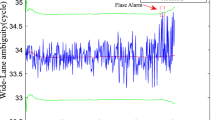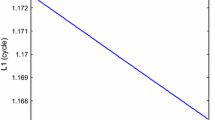Abstract
GNSS undifferenced signal processing, in which the individual signal of each frequency is treated as independent observable, has drawn increasing interest in GNSS community. However, undifferenced signal processing brings new challenges for cycle slip detection and repair. One important feature is the carrier frequency identification of cycle slips since observations are processed separately. An analysis of real cycle slips in a BDS triple-frequency baseline dataset illustrates the deficiencies in the cycle slip detection process commonly implemented, in the case when cycle slips occur in just one specific carrier frequency. Hence, we propose an improved cycle slip detection and repair approach based on a time-differenced model. Two major advantages characterize this proposed approach. The first one is a significant reduction in false alarms due to carrier frequency identification of cycle slips. Having access to a reliable cycle slip detection method significantly reduces the number of ambiguity parameters to be estimated. The second advantage is the benefit of separating the OSS (Observation at the other frequency of Same Satellite without cycle slip) and OSE (Observation at the Same Epoch from other satellites without cycle slip) from the OCS (Observation with Cycle Slip). The simulation results indicate that separation of the OSS and OSE can significantly improve the model strength of cycle slip estimation, especially OSS. The proposed approach is validated by cycle slip estimation with a real data set. Smaller biases and larger ratio values jointly demonstrate that a much stronger model strength can be achieved. Finally, the cycle slip repair procedure is applied to triple-frequency PPP. The stable and fast convergence, as well as the reduction in standard deviations, proves the efficiency of the proposed approach.












Similar content being viewed by others
References
Baarda W (1968) A testing procedure for use in geodetic networks. Delft, Rijkscommissie voor Geodesie
Banville S, Langley RB (2013) Mitigating the impact of ionospheric cycle slips in GNSS observations. J Geodesy 87(2):179–193
Cai CS, Liu ZZ, **a PF, Dai WJ (2013) Cycle slip detection and repair for undifferenced GPS observations under high ionospheric activity. GPS Solutions 17(2):247–260
Chen J, Zhang Y, Wang J, Yang S, Dong D, Wang J, Qu W, Wu B (2015) A simplified and unified model of multi-GNSS precise point positioning. Adv Space Res 55(1):125–134
Dai Z, Knedlik S, Loffeld O. (2008). Real-time cycle slip detection and determination for multiple frequency GNSS. Proceeding of the 5th workshop on Positioning, Navigation and Communication 2008. Hannover, 37-43
Dai Z, Knedlik S, Loffeld O. (2009). Instantaneous triple-frequency GPS cycle slip detection and repair. International Journal of Navigation and Observation, 2009
de Lacy MC, Reguzzoni M, Sansò F, Venuti G (2008) The Bayesian detection of discontinuities in a polynomial regression and its application to the cycle slip problem. J Geodesy 82(9):527–542
de Lacy MC, Reguzzoni M, Sansò F (2012) Real-time cycle slip detection in triple-frequency GNSS. GPS Solutions 16(3):353–362
Feng Y, Gu S, Shi C, Rizos C (2013) A reference station-based GNSS computing mode to support unified precise point positioning and real-time kinematic services. J Geodesy 87(10):945–960
Guo F, Zhang X, Wang J (2015) Timing group delay and differential code bias corrections for BeiDou positioning. J Geodesy 89(5):427–445
Hatch R (1982) The synergism of GPS code and carrier measurements. In: Proceedings of the third international symposium on satellite Doppler positioning at physical sciences laboratory of New Mexico State University, 8–12 Feb, vol. 2, 1213–1232
Huang L, Lu Z, Zhai G, Ouyang Y, Huang M, Lu X, Wu T, Li K (2016) A new triple-frequency cycle slip detecting algorithm validated with BDS data. GPS Solutions 20(4):761–769
Ju B, Gu D, Chang X, Herring TA, Duan X, Wang Z (2017) Enhanced cycle slip detection method for dual-frequency BeiDou GEO carrier phase observations. GPS Solutions 21(4):761–769
Kouba J. (2009). A guide to using International GNSS Service (IGS) products
Liu ZZ (2011) A new automated cycle slip detection and repair method for a single dual-frequency GPS receiver. J Geodesy 85(3):171–183
Melbourne WG. (1985). The case for ranging in GPS-based geodetic systems. In: Proceedings of the first international symposium on precise positioning with the Global Positioning System, Rockville, 373-386
Odijk D, Zhang B, Khodabandeh A, Odolinski R, Teunissen PJ (2016) On the estimability of parameters in undifferenced, uncombined GNSS network and PPP-RTK user models by means of S-system theory. J Geodesy 90(1):15–44
Remondi BW (1985) Global Positioning System carrier phase: description and use. J Geodesy 59(4):361–377
Schönemann E, Becker M, Springer T (2011) A new approach for GNSS analysis in a multi-GNSS and multi-signal environment. Journal of Geodetic Science 1(3):204–214
Shi C, Fan L, Li M, Liu Z, Gu S, Zhong S, Song W (2016) An enhanced algorithm to estimate BDS satellite’s differential code biases. J Geodesy 90(2):161–177
Takasu T, Yasuda A. (2009). Development of the low-cost RTK-GPS receiver with an open source program package RTKLIB. International symposium on GPS/GNSS, Seogwipo-si Jungmun-dong, Korea, 4–6 November, 4-6
Teunissen PJ (1997) A canonical theory for short GPS baselines. J Geodesy 71(8):513–525
Teunissen PJ (1998) Success probability of integer GPS ambiguity rounding and bootstrap**. J Geodesy 72(10):606–612
Teunissen, PJ. (2010). An integrity and quality control procedure for use in multi sensor integration. In ION GPS Redbook Vol. VII Integrated Systems. Institute of Navigation (ION)
Teunissen PJ, Verhagen S (2009) The GNSS ambiguity ratio-test revisited: a better way of using it. Survey Review 41(312):138–151
Tu R, Zhang H, Ge M, Huang G (2013) A real-time ionospheric model based on GNSS Precise Point Positioning. Adv Space Res 52(6):1125–1134
Verhagen S. (2005). The GNSS integer ambiguities: estimation and validation. Ph.D. thesis publications on geodesy, vol 58, Netherlands Geodetic Commission, Delft
Wu Y, ** S, Wang Z, Liu J (2010) Cycle slip detection using multi-frequency GPS carrier phase observations: a simulation study. Adv Space Res 46(2):144–149
Wübbena G (1985) Software developments for geodetic positioning with GPS using TI-4100 code and carrier measurements. Proceedings of the first international symposium on precise positioning with the global positioning system, Rockville 19:403–412
Zehentner N, Mayer-Gürr T (2015) Precise orbit determination based on raw GPS measurements. J Geodesy 90(3):315–327
Zhang Q, Gui Q (2013) Bayesian methods for outliers detection in GNSS time series. J Geodesy 87(7):609–627
Zhang X, Li X (2012) Instantaneous re-initialization in real-time kinematic PPP with cycle slip fixing. GPS Solutions 16(3):315–327
Zhang X, Li P (2015) Benefits of the third frequency signal on cycle slip correction. GPS Solutions 20(3):451–460
Zhao Q, Guo J, Li M, Qu L, Hu Z, Shi C, Liu J (2013) Initial results of precise orbit and clock determination for COMPASS navigation satellite system. J Geod 87(5):475–486. doi:10.1007/s00190-013-0622-7
Zhao Q, Sun B, Dai Z, Hu Z, Shi C, Liu J (2015) Real-time detection and repair of cycle slips in triple-frequency GNSS measurements. GPS Solutions 19(3):381–391
Acknowledgements
Thanks to the IGS and Wuhan University for providing GNSS products. Thanks also go to Dr. **long Li for providing data and Tomoji Takasu for the open RTKLIB source code. We extend much gratitude to the editor in chief Prof. Alfred Leick and to anonymous reviewers for their valuable suggestions. Guorui **, 450052, Zhengzhou, China
Corresponding author
Rights and permissions
About this article
Cite this article
**ao, G., Mayer, M., Heck, B. et al. Improved time-differenced cycle slip detect and repair for GNSS undifferenced observations. GPS Solut 22, 6 (2018). https://doi.org/10.1007/s10291-017-0677-7
Received:
Accepted:
Published:
DOI: https://doi.org/10.1007/s10291-017-0677-7




